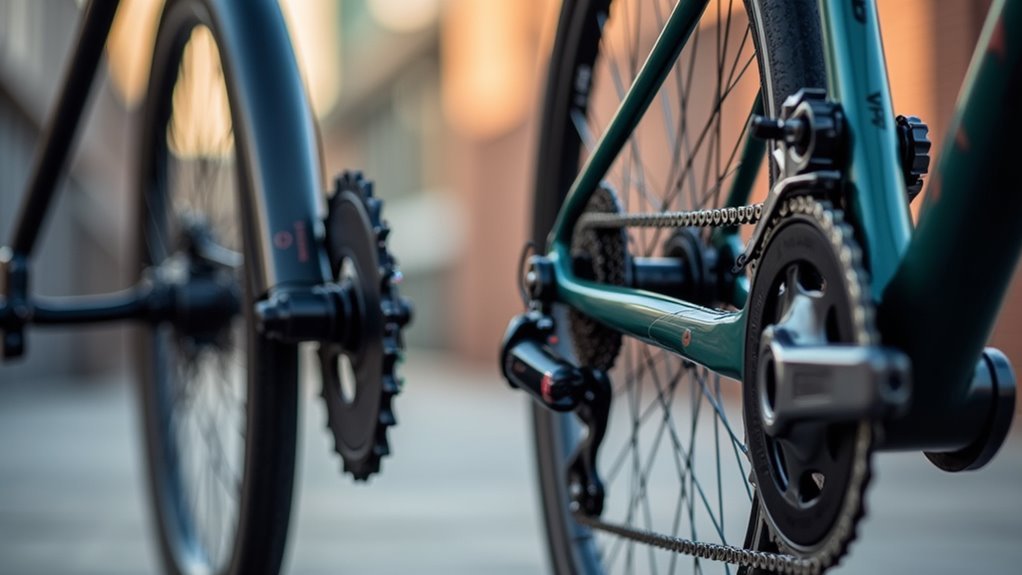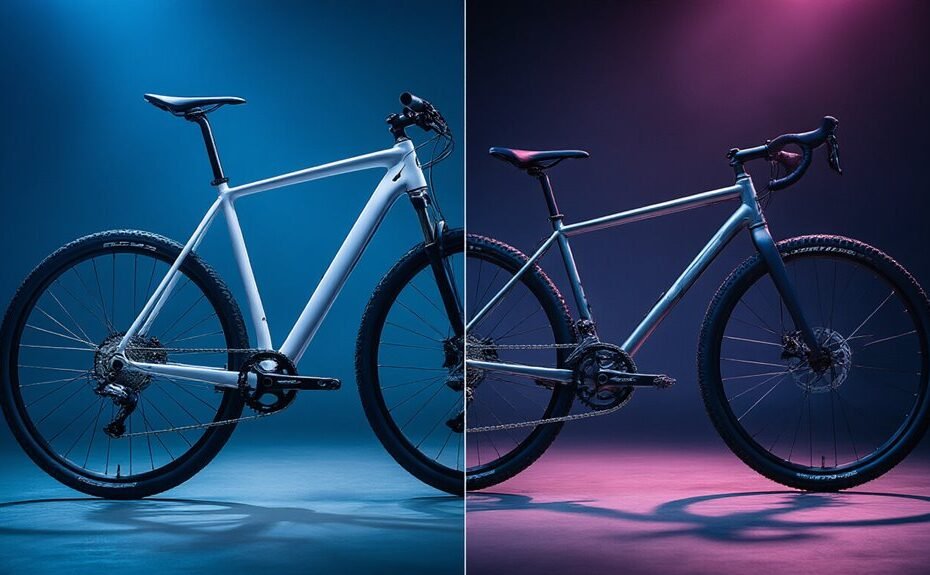The debate between belt drive and chain drive systems has cyclists divided. It’s not a simple black-and-white choice. Each system offers distinct advantages that appeal to different riders. The traditional chain has dominated for decades, while belt drives represent newer technology with growing popularity. Maintenance needs, riding conditions, and personal preferences all factor into this decision. What makes one system better than the other? Well, that depends on what matters most to you.
The Mechanics Behind Belt and Chain Drive Systems
While the fundamentals of bicycle propulsion haven’t changed much over the decades, the mechanics behind belt and chain drive systems reveal substantial differences in their design and operation.
Belt drives feature carbon fiber-reinforced polymers that require minimal maintenance, while chain drives use metal links that need regular cleaning and lubrication.
The efficiency debate isn’t straightforward—chains perform better at low power outputs due to their ability to tolerate slack, whereas belt drives maintain constant tension.
Specialized frames are necessary for belt drives, limiting their compatibility compared to chains, which work with most designs including full-suspension bikes.
This affects both gear ratios and long-term wear considerations.
Durability and Maintenance Comparison
Few aspects of bicycle components reveal more dramatic differences than the durability and maintenance requirements between belt and chain drives.
Belt drives outshine chains in longevity, typically lasting three to four times longer—sometimes exceeding 40,000 km compared to chains’ 10,000 km lifespan.
Maintenance needs are worlds apart too.
Belt drives require just occasional cleaning, while chain drives demand regular lubrication and cleaning to maintain efficiency. This difference affects the drivetrain’s overall performance over time, especially as chains elongate with wear.
Though belt replacement costs around $250, their extended lifespan and minimal maintenance make them more economical in the long run.
Performance and Efficiency Analysis

Performance and efficiency metrics reveal substantial differences between belt and chain drive systems.
Lab tests show belts can match chains at higher power outputs (120-200 watts) but may underperform at lower intensities due to constant tension requirements.
Interestingly, after 5,000-10,000 km of wear, belt drives actually outperform worn chains in efficiency tests. This is primarily because chains elongate over their lifespan, affecting gear meshing.
When paired with gearboxes or internal hubs, belt drives face efficiency losses of 2-6%, making drivetrain configuration essential for performance.
Proper tension maintenance is crucial for belts—too tight, and they’ll wear prematurely; too loose, and performance suffers. Additionally, proper maintenance of recumbent bikes contributes to a longer lifespan and enhanced performance during workouts.
Cost Implications: Initial Investment vs. Long-Term Value
Many cyclists face a significant financial decision when choosing between belt and chain drive systems. The initial investment for belt drives is considerably higher, with replacement drivetrains costing around $250 compared to chain systems‘ lower price point.
While chain drives require regular maintenance and frequent replacement, belt drives offer exceptional longevity—lasting 3-4 times longer and exceeding 40,000 km. For casual riders, this durability might not justify the upfront cost. However, dedicated cyclists who clock significant mileage will find the long-term value of belt drives compelling despite potential repair costs in remote areas. Additionally, considering the maintenance tips associated with each system can influence your decision on investment and upkeep. The Gates SideTrack option offers a middle ground at $100, though with reduced durability.
Choosing the Right Drive System for Your Riding Style

When selecting between belt and chain drive systems, riders must consider how their specific cycling habits align with each option’s distinct advantages.
Urban commuters might prefer belt drives for their minimal maintenance, cleanliness, and quiet riding experience. The higher cost is offset by longevity—lasting 3-4 times longer than chains.
Conversely, adventurous cyclists tackling diverse terrains benefit from chain drives‘ wider gear range and better compatibility with full-suspension bikes. They’re also more practical for those riding in remote areas, where replacement parts are easier to find. Additionally, smart bikes featuring interactive classes can enhance the user’s riding experience, no matter the drive system chosen.
Ultimately, the right choice balances riding style, efficiency, budget, and maintenance preferences.
Frequently Asked Questions
Which Is Better Belt Drive or Chain Drive Bike?
In the race of bicycle propulsion, neither option definitively wins. Belt drives offer superior durability, weather resistance, and reduced maintenance requirements, while chains excel in cost, customization options, and torque transfer performance.
What Are the Disadvantages of a Belt Drive Bike?
Belt drive bikes have limited gear range, higher maintenance costs, compatibility issues with standard frames, parts availability challenges, torque limitations, restricted customization options, and potential durability issues in extreme conditions despite their weather performance advantages.
Why Are Harleys Not Chain Driven?
With belt drives lasting 3-4 times longer than chains, Harley history shows a clear preference for this drive type. Reduced maintenance needs, superior torque delivery, enhanced riding comfort, and aesthetic appeal align with Harley’s premium positioning.
Are Belts or Chains More Efficient?
Efficiency comparison shows chains perform better at low power outputs while belts excel at higher power transfer levels. Belt drives maintain efficiency longer through their lifecycle despite initial maintenance requirements and weight differences.
